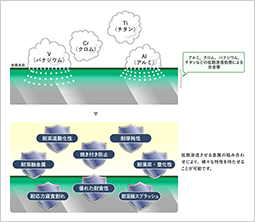
Chromizing (CROCOAT®) treatment is the surface modification method that diffuses chrome (Cr) into a metal surface to form a chrome diffusion layer.
This treatment has the characteristics of abrasion (erosion) resistance, seizure resistance, corrosion resistance, etc., and exerts superior effects.
Chromizing layer applied to medium or high carbon steel, tool steel, and cast iron, is formed the carbide layer (Fe-Cr) which is 15 to 20 ㎛ thickness and 1400 to 1800mHv hardness.
It has the excellent performance of abrasion (erosion) resistance and also has the effect of prevention of seizure.
Chromizing layer applied to austenitic stainless steel, is formed the Cr-Ni-Fe alloy layer which has chrome concentration of 40 to 70wt% in the surface, which is 80 to 120 ㎛ thickness, and 1000 to 1200mHv hardness.
It has the excellent performance of abrasion (erosion) resistance and also has the high effect of corrosion resistance by high chrome diffusion layer.
Austenitic stainless steel with Chromizing (CROCOAT®) treatment has the higher resistance to high-temperature corrosion by low melting point ash at a heavy oil-fired or a coal-fired boiler.

Result of corrosion resistance test for vibrationproof materials at high temperature condition of the heavy oil boiler.
Chromizing (CROCOAT®) treatment generates a Cr2O3 coating film on the surface at a high-temperature oxidation atmosphere.
This coating film prevents the oxidation of base metal by prevention of oxygen permeation.
It is also effective in prevention to the ignition loss of carbon products by high-temperature oxidation.
Chromizing (CROCOAT®) treatment has the general corrosion resistance to nitric acid, alkali, and also has the good corrosion resistance to seawater, petroleum, molten cyanide, and molten chloride.